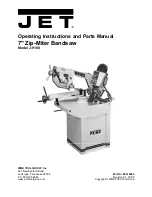
10
Blade Selection
The cut-off saw is delivered with a saw blade
that is adequate for a variety of cut-off jobs on a
variety of common materials. A general-purpose
blade is provided as standard equipment with
the machine.
Optional blades for specific applications are
available from JET. (Refer to the
Parts
section
for saw blade part numbers.)
A coarse blade could be used for a solid steel
bar, but a finer tooth blade would be used on a
thin-wall steel tube. In general, the blade choice
is determined by the thickness of the material;
the thinner the materials; the finer the tooth
pitch.
A minimum of three teeth should be on the
workpiece at all times for proper cutting. The
blade and workpiece can be damaged if the
teeth are so far apart that they straddle the
workpiece.
For very high production on cutting of special
materials, or to cut hard-to-cut materials such as
stainless steel, tool steel, or titanium, call JET
for more specific blade recommendations. JET
can provide you with very specific instructions
regarding the best blade (and coolant or cutting
fluid, if needed) for the material or shape
supplied.
Blade Break-in Procedures
New blades are very sharp and, therefore, have
a tooth geometry that is easily damaged if a
careful break-in procedure is not followed.
Consult the blade manufacturer’s literature for
break-in of specific blades on specific materials.
However, the following procedure will be
adequate for break-in of JET-supplied blades on
lower alloy ferrous materials.
1. Clamp a section of round stock in the vise.
The stock should be 2 inches or larger in
diameter.
2. Operate the saw at low speed. Start the cut
with a very light feed rate.
3. When the saw has completed 1/3 of the cut,
increase the feed rate slightly and allow the
saw to complete the cut.
4. Keep the hydraulic cylinder needle valve in
the same position and begin a second cut
on the same or similar workpiece.
5. When the blade has completed about 1/3 of
the cut, increase the feed rate.
Watch the chip formation until cutting is at its
most efficient rate and allow the saw to
complete the cut (refer to
Evaluating Blade
Efficiency
below).
The blade is now consid-
ered ready for use.
Operations
Hydraulic Feed Control
The weight of the saw head provides the force
needed to cut through the workpiece. The cut-off
saw has a hydraulic cylinder that controls the
feed rate of the saw.
The hydraulic feed control circuit consists of a
single acting
hydraulic cylinder
and a
feed rate
control
. The feed control cylinder resists motion
in the downward direction to control the feed
rate. The control cylinder offers no resistance
when raised upward.
The
feed rate adjustment
(G, Fig. 4) controls the
rate at which the saw head is lowered. The
control knob (needle valve) controls the rate at
which the hydraulic fluid is released from the
hydraulic cylinder. When the needle valve is
closed, the cylinder is locked. With the needle
valve slightly open, the cylinder permits slow, or
light, downward force. Opening the needle valve
further increases the feed rate.
The needle valve is adjusted until the saw is
operating efficiently. The efficiency of operation
is usually evaluated by observing chip formation.
Blade efficiency is further described below.
A
lever
(F, Fig. 5) is used to permit or stop the
saw head from descending regardless of the
feed rate adjustment
(G, Fig. 5) setting.
Evaluating Cutting Efficiency
Is the blade cutting efficiently? The best way to
determine this is to observe the chips formed by
the cutting blade.
If the chip formation is powdery, then the feed is
much too light or the blade is dull.
If the chips formed are curled, but colored – blue
or straw colored from heat generated during the
cut – then the feed rate is too high.
If the chips are slightly curled and are not
colored by heat – the blade is sufficiently sharp
and is cutting at its most efficient rate.
Summary of Contents for J-9180
Page 23: ...23 Saw Assembly Drawing 1 of 3...
Page 24: ...24 Saw Assembly Drawing 2 of 3...
Page 25: ...25 Saw Assembly Drawing 3 of 3...
Page 27: ...27 Electrical Box Assembly...











































